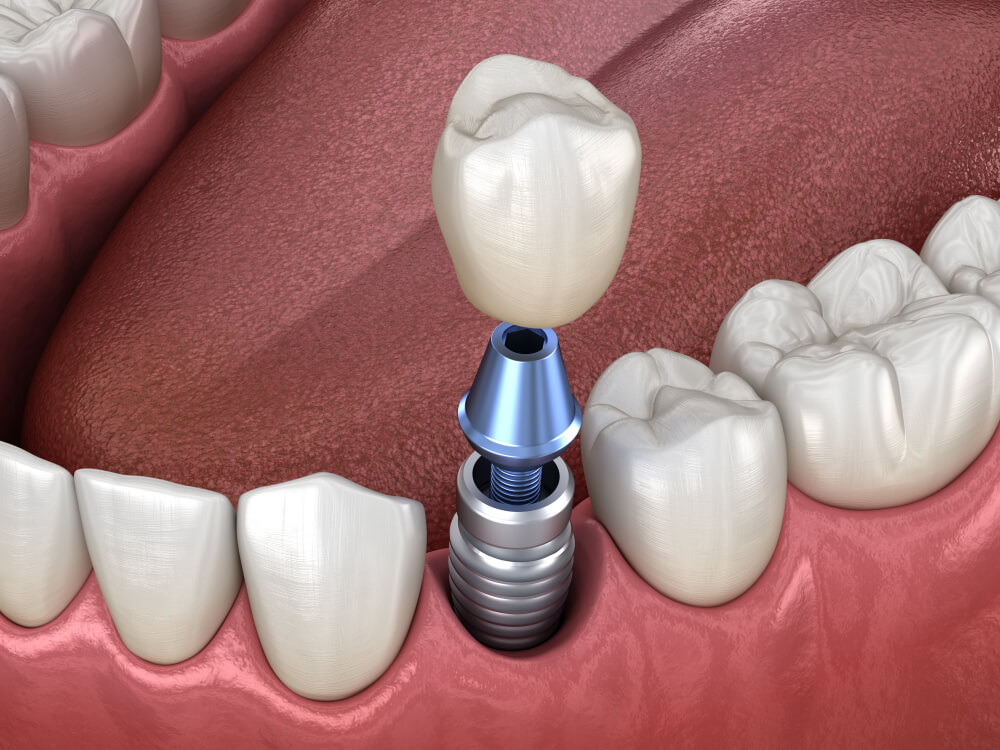Dental implants are artificial tooth roots made from titanium that are placed in the jawbone. As the implant heals, it fuses with the surrounding bone to provide a secure anchor for the placement of a dental prosthetic such as a crown, bridge, or denture. Depending on the number of missing teeth, one or more dental implants can be placed.
Did You Know?
Dental implants are considered to be the “gold standard” of tooth replacement options. This is because they are the strongest, most aesthetically pleasing, and longest lasting tooth replacement option. Additionally, they are the only tooth replacement option that provides the stimulation necessary to preserve bone mass in the jaw.
Frequently Asked Questions:
Am I a candidate for dental implants?
Candidates for dental implants are individuals who have one or more missing teeth. In some cases, candidates may also have one or more severely damaged or decayed teeth in need of extraction. In order to safely have dental implants placed, however, your periodontist will need to perform dental x-rays and an oral exam to make sure you have enough bone mass in your jaw to support the placement of dental implants. To schedule your dental implant consultation at Perio NW, call our office today!
Why should I see a periodontist for dental implants?
Although general dentists can place dental implants, they may refer you to a periodontal specialist if they feel that your case is too complex. Many general dentists will only place dental implants in straightforward cases, and refer out other cases. A periodontal specialist is an ideal dental professional to place dental implants because they have advanced training and extensive experience in placing dental implants.
What can I expect when having dental implants placed at Perio NW?
When having dental implants placed at Perio NW, you can expect a two stage process. During the first stage, you will have your dental implants placed, then during the second stage, you will have your permanent restoration placed. Between the first and second stages, there is generally a 3-6 month period where you will need to wait for your implant to fuse with the surrounding bone.
To place your implants, a minor oral surgery will be performed. During the procedure, you will be anesthetized and placed under conscious sedation. This means that you will be awake and aware of what is happening, however you will not feel any pain or anxiety during the procedure. To begin, Dr. Jan Miesel will make a small incision in your gums to reach the jawbone. Then, the empty tooth socket will be shaped to accommodate a dental implant. The implant screw will then be screwed into the jawbone. At this point, the gums may either be sutured up over the implant or a tiny metal post, called an abutment, will be attached to the implant. The abutment will stick out above the gum tissue and the gums will be sutured around the abutment. A temporary restoration may also be placed as well.
Once your implant has osseointegrated with the surrounding bone, it is strong enough to support your permanent restoration. First, the temporary restoration will be removed, and a dental impression or oral scan will be taken of your mouth. This information is then sent to a dental laboratory and used to fabricate your customized crown, bridge, or denture. Once the permanent restoration has been completed, it will be loaded onto the dental implant(s).
What can I expect after having dental implants placed?
Since having dental implants placed is a minor oral surgery, you can expect to experience some minor discomfort, swelling, and bruising after your procedure. In most cases, this is short-lived and only lasts a week or two after surgery. Because dental implants are placed in areas with very little nerves, they do not often cause extreme pain.
Although your initial recovery period will only last 1-2 weeks, you will still need to closely follow your periodontist’s instructions for the first 3-6 months to ensure that your implant fuses properly. During this time, you can expect to be on a temporary soft foods diet. Once your implant has healed and you have your permanent restoration in place. Then you can return to your normal diet.


